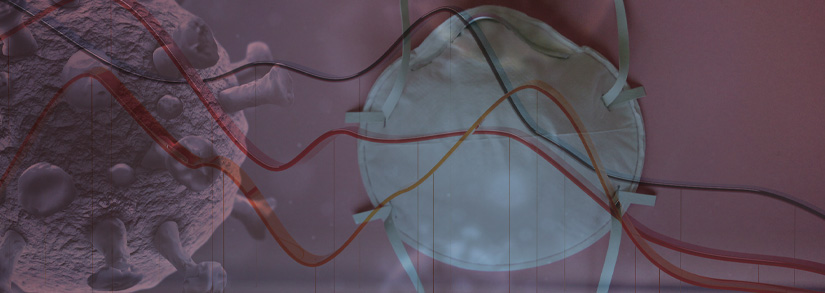
- What can happen to credit strategies when spread curves flatten? We compared a hypothetical barbell portfolio of high-yield bonds to one concentrated in the center of the term structure with similar duration times spread, during the COVID-19 period.
- The barbell strategy outperformed the bullet approach during our 3.5-year study period as credit-spread curves flattened — a sign of heightened near-term default expectations, often seen in periods of high volatility.
- Credit managers may want to go beyond traditional risk-exposure metrics such as spread durations and duration times spread when they expect the slope of spread curves to move significantly.
Short-term credit spreads widened to a greater extent than long-term spreads during the March 2020 COVID-19 crisis. As a result, many U.S. corporate-issuer spread curves flattened or even inverted. What were the implications for corporate-bond investors? We found that a hypothetical “barbell” strategy with spread exposure spread across long- and short-maturity high-yield bonds outperformed a hypothetical “bullet” strategy holding medium-duration high-yield bonds, highlighting the importance of risk exposure to a “credit steepener” factor in a volatile market.
Barbells Beat Bullets During the COVID Crisis
In this analysis, we constructed two hypothetical portfolios with U.S. energy high-yield bonds1 so that they have similar duration times spread (DTS), but with spread durations distributed differently across the term structure. The bullet strategy consists of bonds whose time to maturity ranges from three to six years — with the highest loading of spread key-rate duration (SKRD) on the five-year term. The barbell strategy can be thought of as a combination of two sub-portfolios: a long-duration portfolio that heavily loads on bonds with longer than 10-year time to maturity and a short-duration portfolio of mainly one- to four-year bonds. The SKRDs are therefore more heavily loaded on the two- and 10-year terms. The barbell strategy performed better from January 2018 to May 2021, mainly thanks to a magnified advantage during the COVID crisis: During the drawdown period between Feb. 21 to March 20, 2020, when the bullet portfolio suffered a -29.2% loss of total return, the barbell portfolio limited its loss to -19.7%. We found similar outperformance in other high-yield sectors.2
Barbell Outperformed Bullet Strategy During the COVID Crisis
Using Factors to Keep Up with Spread-Curve Movement
How can we understand the barbell strategy’s outperformance over the bullet strategy’s during the crisis period from a factor perspective? We plot below the portfolio returns explained by two systematic drivers: a DTS factor that captures the parallel movement of high-yield credit spread, and a steepener factor that captures the change in the slope of the spread curves. By construction, the returns of the two strategies explained by the parallel DTS factors tracked each other closely, incurring about a -30% loss during the drawdown (left-hand side of exhibit below). The barbell strategy, however, with spread durations allocated to both the short and long end of the spread curve, regained some ground as spread curves flattened (right-hand side of exhibit). Even though the credit-spread slope has since steepened, the barbell strategy continued to outperform the bullet strategy through May 2021.3
Credit-Steepener Factor Captured Returns Driven by Spread Flattening
Source: MSCI Multi-Asset Class Factor Model
Worsening Expectation of Defaults, Especially in the Short Term
How can we understand the economic intuition behind this movement of the credit curves during the crisis, and what can we learn from this study to inform portfolio-management decisions?
If we think of the corporate-bond prices as discounted future cash flows accounting for the probability of default, we can translate a credit-spread curve to a hazard-rate curve that describes the market-implied default intensity. The plot below illustrates this using the spread and market-implied default-intensity curves of Cheniere Energy Inc. before, during and after the crisis.
During the crisis, when the credit-spread curve inverted, the implied short-term default intensity was elevated much more than that in the long term. This may be interpreted as investors’ having more newfound concerns about the short-term default risk than about the long-term prospects of the company.4
Model-Implied Short-Term Default Probability Increased as Spread Curve Inverted
Source: MSCI Credit Curves
Conclusion
Credit-spread curves typically flatten when investors’ expectation of short-term default risk increases more than that for the long term, as occurred in the credit market during the COVID crisis. Our analysis shows that a hypothetical barbell strategy involving U.S. high-yield energy bonds outperformed a bullet strategy during a 3.5-year period that included the pandemic period, when such spread-curve flattening occurred. Thus, investors may want to go beyond traditional risk-exposure metrics such as spread durations and duration times spread when they expect the slope of spread curves to move significantly.
1We chose the energy sector for this study because it is the largest U.S. high-yield bond sector by market capitalization and had a striking performance during the crisis.
2For investment-grade credit, however, the observation is a mixed bag. One possible explanation is that the flattening of the spread curves is less significant than for their high-yield counterparts.
3In addition to the returns (shown in the second exhibit) from DTS and credit-steepener factors, the term-structure factor’s returns, asset-level idiosyncratic returns and income returns from coupon payment contributed to the total return shown in the first exhibit.
4Relatedly, the Merton model also lends itself to predicting that the short-term credit spread widens more than the long-term spread when the asset value is highly volatile.
Further Reading
Steepener Factors for Credit Model (client access only)
